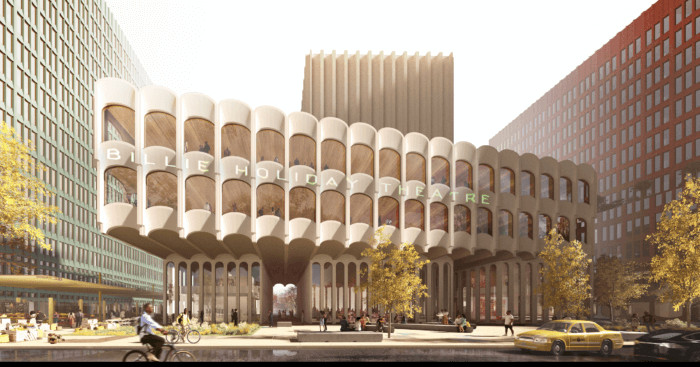The Bedford-Stuyvesant Restoration Corporation is embarking on an ambitious project to transform Restoration Plaza into the “Restoration Innovation Campus,” a dynamic 84,000-square-foot development. This initiative, prominently located on Fulton Street in Brooklyn, is dedicated to addressing community needs and bridging the wealth gap in this rapidly evolving neighborhood.
Designed by the acclaimed architect Sir David Adjaye, in collaboration with local residents through community meetings in 2019, the Restoration Innovation Campus at Fulton Street aims to significantly enhance Restoration Plaza. The plans include expanding the existing cultural center and the renowned Billie Holiday Theatre, alongside creating new public spaces for community engagement. Furthermore, the development will feature two commercial buildings intended to house current tenants and attract new “private, nonprofit, and government partners” who share a commitment to tackling racial economic disparities.
 current restoration plaza
current restoration plaza
Blondel Pinnock, President & CEO of Restoration, emphasized the critical need for this project, stating, “Central Brooklyn mirrors the racial inequities prevalent across urban centers nationwide.” She added, “The Innovation Campus, with its strong focus on Black wealth creation, presents a pioneering and replicable model for closing the wealth gap in communities throughout the United States.”
For over half a century, Restoration has been instrumental in empowering local residents and fostering opportunities. However, Pinnock acknowledged that the “staggering” wealth gap requires a more “bold, new approach.”
Data from the Federal Reserve highlights the severity of the issue, indicating that the average Black and Hispanic or Latino household in the U.S. earns approximately half of what the average white household earns, and possesses significantly less net wealth. This disparity is rooted in historical discriminatory policies leading to lower rates of homeownership and fewer asset holdings among Black Americans. In New York City, Black residents are notably underrepresented in high-paying sectors and often face wage disparities compared to their white counterparts in similar roles. The Treasury Department warns that without intervention, this wealth gap is poised to widen.
Restoration estimates the racial wealth gap in Brooklyn to be between $40 and $50 billion, with long-term residents, particularly people of color, often excluded from the borough’s significant economic growth.
Colvin Grannum, Senior Advisor and former president of Restoration, pointed out Bed-Stuy’s complex reality: “While Bed-Stuy has been a cornerstone of African American culture, it also exemplifies the systemic barriers Black Americans encounter nationwide.” He believes, “Innovation Campus is designed to highlight the growing racial wealth gap and offer a sustainable, self-funding blueprint for Black communities nationwide to bridge this gap and cultivate local wealth.”
The Innovation Campus will enable Restoration to expand its impactful financial programs, including the Software Engineering Fellowship, Business Center, and Center for Personal Financial Health. Larger, modern offices will allow these programs to reach more individuals and broaden their service offerings. The project also incorporates 190,000 square feet of new retail space, which is projected to generate new, well-compensated employment opportunities within the community.
 theater at restoration plaza innovation campus
theater at restoration plaza innovation campus
Community feedback gathered during the visioning phase indicated a strong desire for increased job and educational resources, “mission-aligned retail,” and, most importantly, enhanced arts programming.
Responding to these needs, the campus will feature a revitalized Cultural Center, envisioned as a “state-of-the-art hub” for arts and emerging cultural leaders. Alongside the upgraded Billie Holiday Theatre, the facility will be equipped to host a wider array of performances and arts education initiatives. Restoration also plans to forge partnerships with companies relocating to the Innovation Campus to provide skills training and job placement opportunities for Bed-Stuy residents.
Adjaye articulated the design philosophy: “The design of Innovation Campus draws from Bed-Stuy’s dynamic culture to establish a place-based model capable of disrupting the racial wealth gap.” He further explained, “Informed by extensive community engagement, the design scheme prioritizes public spaces and ensures dedicated areas for collaboration among aligned partners. We are excited to see the campus materialize and serve as an example as Restoration advances this transformative vision.”
Restoration’s history in Brooklyn is deeply rooted. Founded in 1967 through Senator Robert F. Kennedy’s “Special Impact Program,” it became the nation’s first community development corporation. In 1968, it established its base at the former Sheffield Farms milk bottling plant on Fulton Street, which was subsequently transformed into Restoration Plaza. Since then, Restoration has launched numerous programs and public-private partnerships aimed at developing affordable housing, supporting local businesses and schools, and more. According to its website, Restoration has attracted over $500 million in investments to Central Brooklyn.
In 2019, Restoration announced a comprehensive five-year plan to reassess and “redefine its role for the 21st century,” which included the ambitious large-scale renovation of Restoration Plaza, now becoming the Restoration Innovation Campus on Fulton Street, Brooklyn. This project marks a significant step forward in the organization’s ongoing commitment to community empowerment and economic justice in Central Brooklyn.


